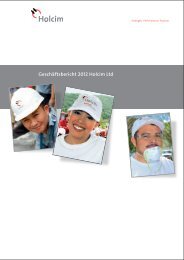Transocean Proxy Statement and 2010 Annual Report
Transocean Proxy Statement and 2010 Annual Report
Transocean Proxy Statement and 2010 Annual Report
Create successful ePaper yourself
Turn your PDF publications into a flip-book with our unique Google optimized e-Paper software.
TRANSOCEAN LTD. AND SUBSIDIARIES<br />
NOTES TO CONSOLIDATED FINANCIAL STATEMENTS — Continued<br />
Pension <strong>and</strong> other postretirement benefit plan obligations represented an aggregate liability in the amount of their net<br />
underfunded status of $469 million <strong>and</strong> $514 million, at December 31, <strong>2010</strong> <strong>and</strong> 2009, respectively. Net periodic benefit costs were<br />
$91 million, $87 million <strong>and</strong> $47 million for the years ended December 31, <strong>2010</strong>, 2009 <strong>and</strong> 2008, respectively. See Note 13—<br />
Postemployment Benefit Plans.<br />
Capitalized interest—We capitalize interest costs for qualifying construction <strong>and</strong> upgrade projects. We capitalized interest<br />
costs on construction work in progress of $89 million, $182 million <strong>and</strong> 147 million for the years ended December 31, <strong>2010</strong>, 2009 <strong>and</strong><br />
2008, respectively.<br />
Derivatives <strong>and</strong> hedging—From time to time, we may enter into a variety of derivative financial instruments in connection with<br />
the management of our exposure to variability in foreign exchange rates <strong>and</strong> interest rates. We record derivatives on our consolidated<br />
balance sheet, measured at fair value. For derivatives that do not qualify for hedge accounting, we recognize the gains <strong>and</strong> losses<br />
associated with changes in the fair value in current period earnings. See Note 12—Derivatives <strong>and</strong> Hedging <strong>and</strong> Note 20—Financial<br />
Instruments <strong>and</strong> Risk Concentration.<br />
We may enter into cash flow hedges to manage our exposure to variability of the expected future cash flows of recognized<br />
assets or liabilities or of unrecognized forecasted transactions. For a derivative that is designated <strong>and</strong> qualifies as a cash flow hedge, we<br />
initially recognize the effective portion of the gains or losses in other comprehensive income <strong>and</strong> subsequently recognize the gains <strong>and</strong><br />
losses in earnings in the period in which the hedged forecasted transaction affects earnings. We recognize the gains <strong>and</strong> losses<br />
associated with the ineffective portion of the hedges in interest expense in the period in which they are realized.<br />
We may enter into fair value hedges to manage our exposure to changes in fair value of recognized assets or liabilities, such as<br />
fixed-rate debt, or of unrecognized firm commitments. For a derivative that is designated <strong>and</strong> qualifies as a fair value hedge, we<br />
simultaneously recognize in current period earnings the gains or losses on the derivative along with the offsetting losses or gains on the<br />
hedged item attributable to the hedged risk. The resulting ineffective portion, which is measured as the difference between the change in<br />
fair value of the derivative <strong>and</strong> the hedged item, is recognized in current period earnings.<br />
Foreign currency—The majority of our revenues <strong>and</strong> expenditures are denominated in U.S. dollars to limit our exposure to<br />
foreign currency fluctuations, resulting in the use of the U.S. dollar as the functional currency for all of our operations. Foreign currency<br />
exchange gains <strong>and</strong> losses are primarily included in other income (expense) as incurred. We had a net foreign currency exchange gain of<br />
less than $1 million for the year ended December 31, <strong>2010</strong>. We had net foreign currency exchange losses of $34 million <strong>and</strong> $3 million for<br />
the years ended December 31, 2009 <strong>and</strong> 2008, respectively.<br />
Income taxes—We provide for income taxes based upon the tax laws <strong>and</strong> rates in effect in the countries in which operations are<br />
conducted <strong>and</strong> income is earned. There is little or no expected relationship between the provision for or benefit from income taxes <strong>and</strong><br />
income or loss before income taxes because the countries in which we operate have taxation regimes that vary not only with respect to<br />
nominal rate, but also in terms of the availability of deductions, credits <strong>and</strong> other benefits. Variations also arise because income earned<br />
<strong>and</strong> taxed in any particular country or countries may fluctuate from year to year.<br />
We recognize deferred tax assets <strong>and</strong> liabilities for the anticipated future tax effects of temporary differences between the<br />
financial statement basis <strong>and</strong> the tax basis of our assets <strong>and</strong> liabilities using the applicable jurisdictional tax rates in effect at year end. We<br />
record a valuation allowance for deferred tax assets when it is more likely than not that some or all of the benefit from the deferred tax<br />
asset will not be realized. We provide a valuation allowance to offset deferred tax assets for net operating losses (“NOL”) incurred during<br />
the year in certain jurisdictions <strong>and</strong> for other deferred tax assets where, in our opinion, it is more likely than not that the financial statement<br />
benefit of these losses will not be realized. We provide a valuation allowance for foreign tax credit carryforwards to reflect the possible<br />
expiration of these benefits prior to their utilization.<br />
We maintain liabilities for estimated tax exposures in our jurisdictions of operation, <strong>and</strong> the provisions <strong>and</strong> benefits resulting from<br />
changes to those liabilities are included in our annual tax provision along with related interest <strong>and</strong> penalties. Tax exposure items include<br />
potential challenges to permanent establishment positions, intercompany pricing, disposition transactions, <strong>and</strong> withholding tax rates <strong>and</strong><br />
their applicability. These exposures are resolved primarily through the settlement of audits within these tax jurisdictions or by judicial<br />
means, but can also be affected by changes in applicable tax law or other factors, which could cause us to revise past estimates. See<br />
Note 6—Income Taxes.<br />
Reclassifications—We have made certain reclassifications to prior period amounts to conform with the current year’s<br />
presentation. These reclassifications did not have a material effect on our consolidated statement of financial position, results of<br />
operations or cash flows.<br />
Subsequent events—We evaluate subsequent events through the time of our filing on the date we issue our financial<br />
statements. See Note 25—Subsequent Events.<br />
AR-81

















